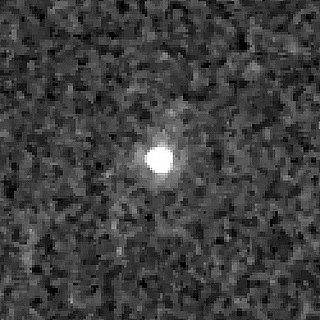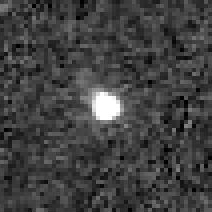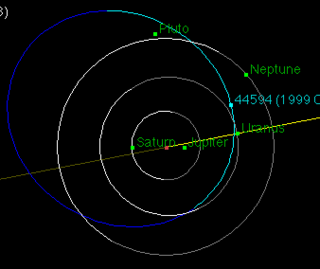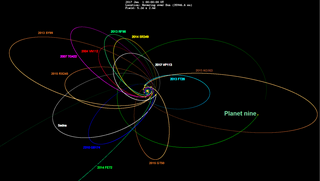Related Research Articles
(65407) 2002 RP120 (provisional designation 2002 RP120) is a trans-Neptunian object and damocloid from the outer Solar System. Its orbit is retrograde and comet-like, and has a high eccentricity. It was discovered on 4 September 2002 by astronomers with the LONEOS survey at Anderson Mesa Station, Arizona, in the United States. The unusual object measures approximately 14.6 kilometers (9.1 miles) in diameter and is likely elongated in shape. It is a slow rotator and potentially a tumbler as well. The object was probably ejected from the ecliptic by Neptune.

(42301) 2001 UR163 (provisional designation 2001 UR163) is a resonant trans-Neptunian object and possible dwarf planet located in the outermost region of the Solar System. The object measures approximately 352 kilometers (220 miles) in diameter with a high albedo and stays in an uncommon orbital resonance (4:9) with Neptune. It was discovered on 21 October 2001 by astronomers of the Deep Ecliptic Survey program at Kitt Peak National Observatory near Tucson, Arizona, United States. As of 2021, it has not been named.

(40314) 1999 KR16 is a trans-Neptunian object on an eccentric orbit in the outermost region of the Solar System, approximately 254 kilometers (158 miles) in diameter. It was discovered on 16 May 1999, by French astronomer Audrey Delsanti and Oliver Hainaut at ESO's La Silla Observatory in northern Chile. The very reddish object is a dwarf planet candidate and has a rotation period of 11.7 hours.

(44594) 1999 OX3 is an eccentric trans-Neptunian object with a centaur-like orbit from the outer Solar System, approximately 150 kilometers in diameter. It was discovered on 21 July 1999, by astronomers John Kavelaars, Brett Gladman, Matthew Holman and Jean-Marc Petit at Mauna Kea Observatories, Hawaii, United States.
(589683) 2010 RF43 (provisional designation 2010 RF43) is a large trans-Neptunian object orbiting in the scattered disc in the outermost regions of the Solar System. The object was discovered on 9 September 2010, by American astronomers David Rabinowitz, Megan Schwamb and Suzanne Tourtellotte at ESO's La Silla Observatory in northern Chile.
(445473) 2010 VZ98 (provisional designation 2010 VZ98) is a trans-Neptunian object of the scattered disc, orbiting the Sun in the outermost region of the Solar System. It has a diameter of approximately 400 kilometers.
2010 TJ is a trans-Neptunian object from the scattered disc in the outermost region of the Solar System and measures approximately 460 kilometers in diameter. It was first observed by American astronomers David Rabinowitz, Megan Schwamb, and Suzanne Tourtellotte at ESO's La Silla Observatory in northern Chile on 2 October 2010.

(82158) 2001 FP185 (provisional designation 2001 FP185) is a highly eccentric trans-Neptunian object from the scattered disc in the outermost part of the Solar System, approximately 330 kilometers in diameter. It was discovered on 26 March 2001, by American astronomer Marc Buie at Kitt Peak National Observatory in Arizona, United States.
(78799) 2002 XW93, provisional designation 2002 XW93, is a trans-Neptunian object and centaur from the outer Solar System, approximately 500–600 kilometers (300–400 mi) in diameter. It was discovered on 10 December 2002, by astronomers at the Palomar Observatory in California.

2015 RX245 is an extreme trans-Neptunian object, detached, on a highly eccentric orbit in the outermost region of the Solar System. It measures approximately 250 kilometers (160 miles) in diameter and is "possibly" a dwarf planet. It was first observed on 8 September 2015, by astronomers with Outer Solar System Origins Survey using the 3.6-meter Canada–France–Hawaii Telescope at Mauna Kea Observatories, Hawaii, in the United States.

(127546) 2002 XU93, provisional designation 2002 XU93, is a trans-Neptunian object and centaur on highly inclined and eccentric orbit in the outer region of the Solar System. It measures approximately 170 kilometers (110 mi) in diameter and is one of few objects with such an unusual orbit. It was discovered on 4 December 2002, by American astronomer Marc Buie at the Kitt Peak National Observatory in Arizona, United States.
2005 RH52 is an extreme trans-Neptunian object from the extended scattered disc in the outermost region of the Solar System, approximately 130 kilometers (81 miles) in diameter. It was first observed on 3 September 2005, by astronomers with the Canada–France Ecliptic Plane Survey using the Canada–France–Hawaii Telescope at the Mauna Kea Observatories in Hawaii, United States.

2013 FS28 is an extreme trans-Neptunian object from the extended scattered disc on a highly eccentric orbit in the outermost region of the Solar System. It measures approximately 466 kilometers (290 miles) in diameter. The detached, extended scattered disc object belongs to the group of extreme trans-Neptunian objects. It was first observed on 16 March 2013, by American astronomers Scott Sheppard and Chad Trujillo at the Cerro Tololo Observatory in Chile.
2013 UH15 is an extreme trans-Neptunian object from the extended scattered disc in the outermost region of the Solar System, approximately 130 kilometers (81 miles) in diameter. It was first observed on 29 October 2013, by astronomers at the Las Campanas Observatory in the southern Atacama Desert of Chile. The detached extended scattered disc object (ESDO) is on a highly eccentric orbit and belongs to the extreme trans-Neptunian objects.
(523727) 2014 NW65 (provisional designation 2014 NW65) is a large centaur from the outer Solar System, approximately 220 kilometers (140 miles) in diameter. It was discovered on 14 July 2010 by astronomers with the Pan-STARRS-1 survey at Haleakala Observatory, Hawaii, in the United States. The minor planet was numbered in 2018 and has not been named.
(468861) 2013 LU28, provisional designation 2013 LU28 is a highly eccentric trans-Neptunian object, retrograde centaur and damocloid from the outer regions of the Solar System. It was discovered on 8 June 2013 by astronomers with the Mount Lemmon Survey at the Mount Lemmon Observatory in Arizona, United States. The object is unlikely a dwarf planet as it measures approximately 110 kilometers (68 miles) in diameter. It was numbered in 2016 and has not been named since.
(523635) 2010 DN93 (provisional designation 2010 DN93) is a trans-Neptunian object from in the scattered disc located in the outermost region of the Solar System. It was discovered on 26 February 2010, by astronomers with the Pan-STARRS survey at Haleakala Observatory on the island of Maui, Hawaii, in the United States. Assuming a low albedo, the object is estimated at approximately 490 kilometers (300 miles) in diameter. It was numbered in 2018 and remains unnamed.
(523706) 2014 HF200 (provisional designation 2014 HF200) is a trans-Neptunian object on an eccentric orbit from the scattered disc, located in the outermost region of the Solar System. It was discovered on 20 May 2012, by astronomers with the Pan-STARRS survey at Haleakala Observatory, Hawaii, United States. The dwarf planet candidate measures approximately 300 kilometers (190 miles) in diameter.
(523683) 2014 CP23 (provisional designation 2014 CP23) is a trans-Neptunian object from the scattered disc located in the outermost region of the Solar System It was discovered on 29 October 2011, by astronomers with the Pan-STARRS survey at Haleakala Observatory, Hawaii, United States. The dwarf planet candidate measures approximately 267 kilometers (170 miles) in diameter.
(495603) 2015 AM281 (provisional designation 2015 AM281) is a resonant trans-Neptunian object in the outermost region of the Solar System, guesstimated at approximately 470 kilometers (290 miles) in diameter. It was discovered on 13 March 2010, by astronomers with the Pan-STARRS survey at Haleakala Observatory, Hawaii, United States.
References
- 1 2 3 4 5 6 7 8 "(527603) 2007 VJ305". Minor Planet Center. Retrieved 29 May 2019.
- 1 2 "List Of Centaurs and Scattered-Disk Objects". Minor Planet Center. Retrieved 25 October 2018.
- 1 2 3 4 5 "JPL Small-Body Database Browser: (2007 VJ305)" (2018-02-04 last obs.). Jet Propulsion Laboratory . Retrieved 29 May 2019.
- 1 2 3 4 5 6 "List of Known Trans-Neptunian Objects". Johnston's Archive. 7 October 2018. Retrieved 25 October 2018.
- 1 2 3 4 5 Brown, Michael E. "How many dwarf planets are there in the outer solar system?". California Institute of Technology . Retrieved 25 October 2018.
- 1 2 3 4 5 "Asteroid 2007 VJ305". Small Bodies Data Ferret. Retrieved 25 October 2018.
- ↑ "Database Query: objects q>30, a>150". Minor Planet Center. Retrieved 25 October 2018.
- ↑ "MPC/MPO/MPS Archive". Minor Planet Center. Retrieved 29 May 2019.
- ↑ "LCDB Data for (2007+VJ305)". Asteroid Lightcurve Database (LCDB). Retrieved 25 October 2018.